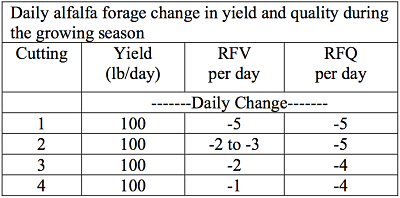Change in Yield and Quality of Alfalfa
by Dan Undersander, Extension Forage Agronomist
Many growers are asking about the tradeoffs in alfalfa yield and quality as they enter quality pricing contracts for hay or haylage. This is difficult to assess since both alfalfa growth and forage quality vary considerably depending on environmental conditions. The USDA-Dairy Forage Research Center conducted a detailed study (jointly with the Universities of Pennsylvania and Idaho) to attempt to get some answers. This data along with some of mine can give a few benchmarks.
First, from the studies, it seems reasonable to plan on the yield increase of alfalfa near harvest being about 100 lbs per acre per day if growing conditions are ‘average.’ This was the average yield change across cuttings, exclusive of late fall and in all three states. However, yield change per day around harvest time varies considerably and has ranged from 0 to 200 lbs per acre per day. The daily yield increase will be less in cool, cloudy weather, and if insects, disease or drought occur. It may be greater in periods of good moisture, sunshine and 75 to 85 degree weather. We should also keep in mind that 3 cuttings taken at 10% bloom will yield about 15 to 20% more than 4 cuttings taken at the bud stage.
Second, we have analyzed forage quality changes with advancing maturity over time across each harvest of alfalfa for several years. It appears that quality of first cutting changes at the fastest rate while later cuttings change in fiber and digestibility at a slower rate. We have found that first cutting decreases about 5 pts RFV per day, second cutting decreases 2 to 3 points per day and third and fourth cutting during the growing season decline 1 to 2 points per day. The late fall growth may change little in forage quality during mid to late September and early October. Relative Forage Quality (RFQ) will change about the same as RFV on first cutting and then decline about 4 points per day on 2nd, 3rd and 4th cuttings during the growing season. Factors such as drought and potato leaf hopper will dramatically reduce yield but increase forage quality.
 Growers should target the forage quality for the animal being fed or the market. The table to the left will allow the grower to calculate changes versus the payment basis for quality of forage. Remember that the change in quality is on the total forage harvested for the
Growers should target the forage quality for the animal being fed or the market. The table to the left will allow the grower to calculate changes versus the payment basis for quality of forage. Remember that the change in quality is on the total forage harvested for the
cutting (usually 1.5 to 2 t/a per cutting). These numbers can also be used with the hay cut date spreadsheet available at my website (www.uwex.edu/ces/forage) to estimate optimum return based on yield and value of quality. The numbers suggest that the maximum return to grower with an RFQ (RFV) premium of $0.60 per point of RFQ/ton is to harvest 130 RFV (RFQ), for $0.80/RFQ/ton is 140 and for $1.00 is 155. Dairy quality hay is generally considered to be 150 RFV (RFQ) or higher.




